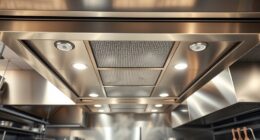Combining UV-C disinfection with your HVAC system can boost indoor air quality by targeting airborne pathogens directly within your airflow. To do this effectively, focus on optimizing airflow so contaminated air passes through UV-C light zones evenly. Proper lamp placement, regular maintenance, and balanced fan speeds are key to maximizing germicidal efficiency. If you want to discover how these strategies work together seamlessly, there’s more to explore on integrating UV-C into your system for healthier indoor air.
Key Takeaways
- Integrate UV-C lamps within HVAC airflow pathways to ensure direct contact with passing air for effective disinfection.
- Optimize airflow design for uniform distribution, maximizing UV-C exposure and germicidal efficiency.
- Position UV-C lights strategically to target high-traffic or high-contamination zones within the system.
- Regularly maintain and clean UV-C lamps and airflow components to sustain disinfection performance.
- Balance fan speed to ensure sufficient UV-C contact time without compromising energy efficiency or airflow quality.

UV-C disinfection has become an indispensable tool in enhancing indoor air quality, especially when integrated with HVAC systems. When you combine UV-C technology with your HVAC setup, you create a powerful defense against airborne pathogens, mold, and bacteria. To maximize its effectiveness, airflow optimization plays a vital role. Proper airflow ensures that contaminated air passes through the UV-C light zone efficiently, increasing germicidal efficiency. If airflow is uneven or sluggish, some areas may not receive adequate exposure, reducing overall disinfection performance. By designing your system to promote uniform airflow, you can ensure every cubic foot of air gets treated thoroughly.
Incorporating UV-C within your HVAC system means you need to carefully position the lamps for ideal airflow contact. Proper placement allows air to pass directly over the UV-C bulbs, where the germicidal effect is strongest. This strategic positioning minimizes dead zones and turbulence, which can otherwise allow pathogens to escape treatment. When airflow is optimized, the UV-C light can effectively deactivate a broader spectrum of microorganisms, considerably reducing the risk of illness spread indoors.
Germicidal efficiency depends largely on how well the UV-C light interacts with the air moving through your system. The intensity of UV-C radiation diminishes with distance, so proximity to the airflow pathway matters. You want the UV-C lamps installed in a way that the air encounters the highest germicidal doses possible. Additionally, maintaining proper lamp cleanliness and ensuring the UV-C bulbs are functioning at their rated intensity are key to sustaining germicidal efficiency over time.
Another factor to consider is the speed of airflow. If air moves too quickly, it might not spend enough time under the UV-C light to ensure complete germicidal action. Conversely, airflow that’s too slow could lead to energy inefficiencies and increased pressure drop within your system. Finding the right balance involves calibrating fans and airflow rates to optimize both germicidal effectiveness and energy consumption. Regular maintenance, including cleaning the UV-C lamps and checking airflow pathways, helps maintain peak efficiency.
Ultimately, when you integrate UV-C disinfection with your HVAC system, attention to airflow optimization and germicidal efficiency ensures you get the maximum health benefits. Proper design, installation, and maintenance allow UV-C to work seamlessly with your existing ventilation, delivering cleaner, safer indoor air. This combination not only helps prevent the spread of airborne diseases but also improves overall indoor air quality, making your environment healthier and more comfortable for everyone.
Frequently Asked Questions
How Does UV-C Disinfection Impact HVAC Energy Efficiency?
You’ll find that UV-C disinfection can improve HVAC energy efficiency by promoting airflow optimization, which helps your system operate more smoothly. As a result, energy consumption decreases because your HVAC doesn’t have to work as hard to circulate and clean the air. By integrating UV-C, you reduce microbial buildup, keeping components clean and functioning efficiently, ultimately saving you energy and lowering your utility bills.
Are UV-C Systems Suitable for All Building Types?
You might wonder if UV-C systems suit your building type. They’re generally effective in many settings, but building codes and specific ventilation needs vary. Installation costs can be higher for larger or complex systems, so you should consult local regulations and HVAC professionals. While not suitable for all buildings, UV-C disinfection can considerably improve air quality when properly installed, especially in healthcare, commercial, or high-traffic environments.
What Are the Maintenance Requirements for UV-C Disinfection Units?
Think of your UV-C disinfection unit as a delicate plant needing care. You should regularly check the UV-C bulb lifespan and replace bulbs before they dim. Follow a strict system cleaning schedule to prevent dust buildup, which can block UV-C light. Also, inspect electrical connections and filters periodically. Staying proactive guarantees your UV-C system stays effective, like a well-tended garden blooming with clean, disinfected air.
Can UV-C Disinfection Eliminate All Airborne Pathogens?
UV-C disinfection substantially reduces airborne pathogens, but it can’t eliminate all of them completely. Its effectiveness depends on factors like exposure time, airflow, and pathogen type. You should understand that UV-C light weakens or kills many microorganisms, but some may survive or be shielded. To maximize UV-C effectiveness, combine it with proper HVAC maintenance and filtration. Relying solely on UV-C isn’t enough for complete airborne pathogen elimination.
What Safety Measures Are Necessary When Installing UV-C in HVAC?
You should prioritize UV-C safety and follow installation precautions to prevent harm. Wear protective gear like goggles and gloves during installation, and guarantee UV-C lights are properly shielded to avoid direct exposure. Turn off HVAC systems during setup, and verify that UV-C devices are correctly installed according to manufacturer instructions. Regular maintenance and safety checks are essential to keep everyone protected and ensure effective disinfection.
Conclusion
By combining UV-C disinfection with your HVAC system, you’re fundamentally creating an unstoppable fortress against germs. This powerful duo not only cleans the air but also protects your space like an impenetrable shield. Don’t underestimate the importance—it’s like having a microscopic army fighting 24/7 to keep your environment safe. Embrace this cutting-edge technology today, and turn your HVAC system into the most formidable defense against airborne threats you’ve ever seen!










